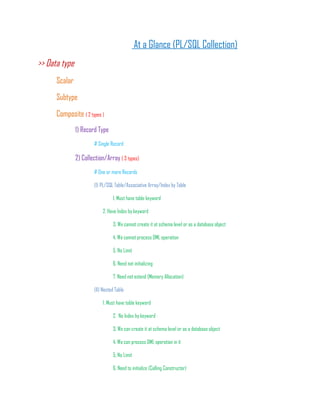Collection - PL/SQL
- 1. At a Glance (PL/SQL Collection) >> Data type Scalar Subtype Composite ( 2 types ) 1) Record Type # Single Record 2) Collection/Array ( 3 types) # One or more Records (I) PL/SQL Table/Associative Array/Index by Table 1. Must have table keyword 2. Have Index by keyword 3. We cannot create it at schema level or as a database object 4. We cannot process DML operation 5. No Limit 6. Need not initializing 7. Need not extend (Memory Allocation) (II) Nested Table 1. Must have table keyword 2. No Index by keyword 3. We can create it at schema level or as a database object 4. We can process DML operation in it 5. No Limit 6. Need to initialize (Calling Constructor)
- 2. 7. Need to extend (Memory Allocation) (III) Varray 1. Must have varray keyword 2. No Index by keyword 3. We can create it at schema level or as a database object 4. We can process DML operation in it 5. Must have Limit keyword 6. Need to initialize (Calling Constructor) 7. Need to extend (Memory Allocation) >>>>> Humayun Kabir <<<<< Humayun.kabir82@yahoo.com


